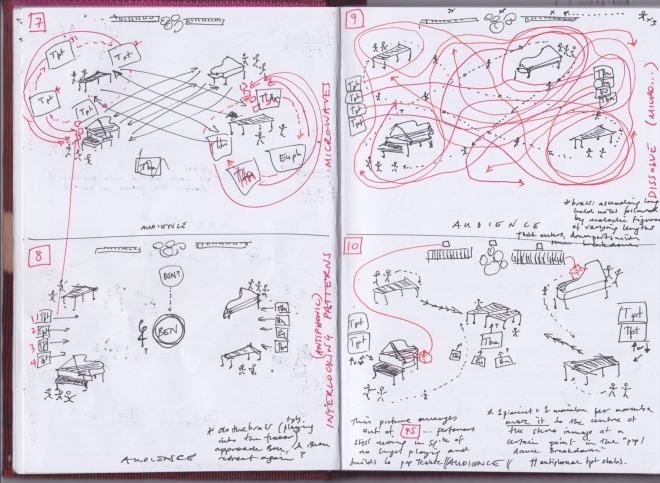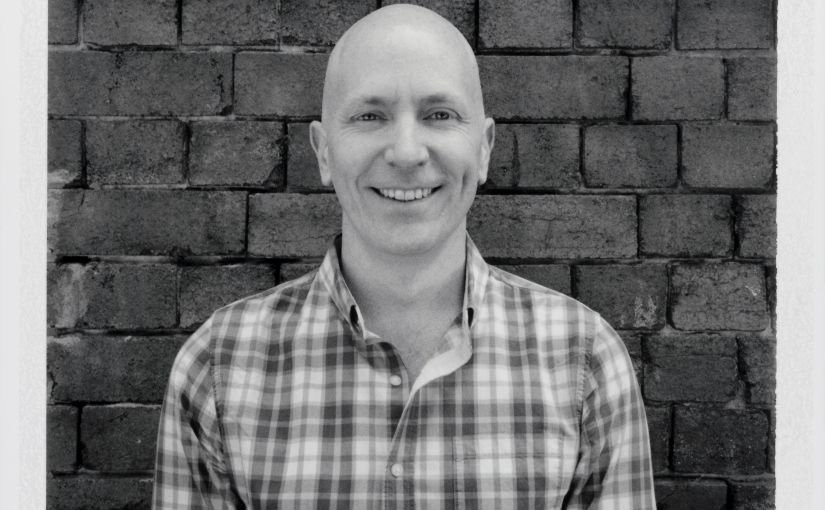Harry Matthews (HM): As a composer you have such a diverse and creative output. For you, is there a separation between the creative process of composing a film score and composing Waves Of… (the piece featured at the upcoming SHIFTS concert)?
Drew Crawford (DC): The short answer to that is, no. I would say that when I was younger, I might have felt there was more of a separation. But really, the creative process comes down to, what is your trigger, why you are doing what you’re doing, and what are the restrictions that you have; those restrictions could be budget, schedule/time, and the context to which it will be performed (dance club, theatre, concert hall). And you then you work with all those parameters and it’s exciting! So with a film score for example, a lot of restrictions come externally from the director, producer and the script. But with something like Waves of… there are still plenty of restrictions, and I like to put these restrictions on my resources because it allows me to focus on my creativity, which is of course an old Stravinskian notion. That’s the longer answer!
HM: You have spoken about how many of your compositions exist as studio works, a sound world in which you have full control. How does moving to the materiality of live performance, where often parts of the situation are out of your control, change your role as a composer?
DC: That’s an interesting question, I think it’s important to point out that I started in live performance with real musicians, in a real space in real time. I think I was frustrated with some of the limitations of the materiality of sound, where you can’t control the space etc… I think I struggled with those things quite a lot, but because I didn’t know as much about sound when I was younger, I just accepted it. And then having spent a good 10 years working in studios, through my work, I better understood how sound operates, how you can control it in a studio environment and how you can attempt to control it in an acoustic environment. Coming back to the concert hall has been, still, really frustrating! So Waves Of… is an example of a piece where I’m thinking about the acoustic, and what the acoustic can mean and using that as a starting point. There is no point fighting with my frustrations, writing something that I want to be really dry and short, and being disappointed when it sounds all messy in a large concert hall [Turner Sims has a beautifully resonant sound, something that doesn’t suit all musical styles]. So I’ve confronted this in Waves Of… by thinking about textures that can float. And I’ve been thinking about how I can effect the directionality of a sound within a space. For example, having two marimbas spaced far apart on the stage, and when they’re pushing a note between them it’s as if the sound is moving around the space, suspended between the two instruments. I’m also working with electronics [in Waves Of…], and the way they’re placed around the stage which will give a much more immediate impact. So moments that I want to sound close, direct or immersive are electronically mediated. Moments that I want to have a slightly more diffuse character are live. The live elements plays between things being asynchronous [happening at the same time] to things being rigidly synchronised and I’m interested in what this sounds like in a reverberant space. So when material is asynchronous in a reverberant space it has a lovely smudged cloud-like quality and when things are synchronised we start to hear the sound of the space clearly, as a distinct sound entity.
Drew Crawford’s sketches for Waves Of…

HM: So you’re taking the practice of mixing in a studio environment, manipulating the space using processing tools (pan, EQ, compression etc.), and using this approach with live musicians.
DC: Absolutely, that’s exactly what it is. The thing is, I can’t not think about those things now.
HM: Waves Of… explores the difference between oscillations and stillness. Could you tell me a bit more about this?
DC: So this comes back to the idea about moving a sound around space, so we’ve set up the idea that sound can move around the space physically, using the position of instruments to show this. There are two marimbas, performed by two people each, spaced at opposite ends of the concert hall, moving the sound around them. And that becomes your foreground interest, the way the sound is moving, and the obvious contrast is for that to stop. So we experience stillness. There are also two pianos at opposite ends, each with three players. So there are sounds being moved around by both the marimbas and pianos, and so we can think about them as being contrapuntal [two separate ideas being played at the same time]. With the increase of players on each instrument, you can increase the number layers of movement that you have and think about them as being counterpoints to each other. So that will become a very complex texture, even if its not harmonically complex, there is a lot going on with sounds moving around the space. In order to contrast this is using silence or stillness. So I’m playing with the idea of giving people a break every now and then, just to reset their ears but also to excite and then calm them down. And I don’t think that’s any different to what we would do melodically, rhythmically or harmonically – I’m just thinking about it in terms of texture and space.
HM: Tension and release!
DC: Absolutely tension and release, it’s a fundamental compositional principle.
HM: During the opening of the piece, we hear passages of music that are specified in seconds. Do the performers have stopwatches or does the conductor control the changes between material?
DC: Well I’m trying to control the amount that the conductor is on stage, I want everything to feel as organic as possible. I have timings that are also approximations and we have been working out during rehearsals how long each section will last. In terms of stopwatches, these would only be used during rehearsals, I want them to internalise the length of the sections to what feels good. In one of our rehearsals recently I realised that I’m thinking, possibly because I’ve done a lot of work in the theatre and with dancers, that I’m approaching the score much more like a script. All the musicians have a full copy of the score, so that they can see what their part is within the group. So when the score says for example, play for 30 seconds, if we decide during the rehearsal that this is better off being around 20 seconds that’s what we’ll go for. But this won’t be by looking at a stopwatch, I want them to do what feels right for them, me as a composer and what works in that space before moving onto the next passage or idea.
HM: You mention that this piece is exploring the concept of waves as a metaphor for our history and our politics, by this do you mean the shift in attitudes towards movements such as Feminism?
DC: [Feminism] wasn’t specifically in my mind, but yes we do talk about waves of Feminism. I was thinking in general, waves of ideas and that ideas come in waves. If we are thinking about the way waves work, they can be transmitted, reflected, refracted etc. and we often use waves as a way of describing movements, such as Feminism. Waves can be amplified, accentuated or attenuated. So I’m conscious of these ideas as a composer and someone who works with sound. But I’m also very aware of how we use waves as metaphors, and I think at the moment things are pretty terrible, globally we’re in a pretty dark place. I suppose what I’m trying to do is cope with that by thinking about it as, yes there is a lot of echoing and reverberation bouncing around, and I have to believe that we can cancel some things out or introduce a new wave . It feels like there’s some splash back, I think a couple of years ago people thought we are at a point there are certain political movements that have been sub-frequencies and now they’re deafening.
We also talk about waves of emotion. We do experience our emotional lives in waves, we talk about ‘a wave of fear’ or ‘waves of love, pleasure’ and again, all the actions that people take publicly are directly related to internal emotional states. Those are obviously really huge ideas and this piece doesn’t seek to say anything profound, but to draw our attention to them. If this ideas of waves as a metaphor as a way of describing emotion opens political discussion, hopefully this is something you can sit with for a while, in relation to the music and allow it to germinate a little bit.
HM: I think that is really apt, considering the current political climate. Emotions are high on both sides of the fence right now, and it’s important to take emotions into consideration.
HM: So for my final question, it would be great to know what you’re up to at the moment and your future plans?
DC: I am continuing to investigate this idea of spatialising live performance and mixing it with electronics. I’m interested in doing a lot more in this space, either with students at the University or with other ensembles. I will be looking into different contexts, including site-specific performance and gallery spaces. I have a few ideas of how I want to work with that going forward. On the complete other end of the spectrum, I’ve got a handful of bangin’ dance pop tracks that are finished and I’ve just got to find the time to release them to the world! I continue to do commercial work for various multimedia projects. One of the things I’m appreciating much more as I get older is how my experiences fit into each other. So experimenting with the HARTLEY Loop Orchestra on these ideas feeds into my commercial work, and similarly the opportunities I get through my commercial work completely influence my ‘art’ work. I don’t want to restrict the kind of projects I do, but it’s nice that all my projects can fit in with each other, which is really exciting!
You can find out more about Drew Crawford on his website here.
This interview was conducted by video chat on 24 January 2019

One thought on “Interview with Drew Crawford”